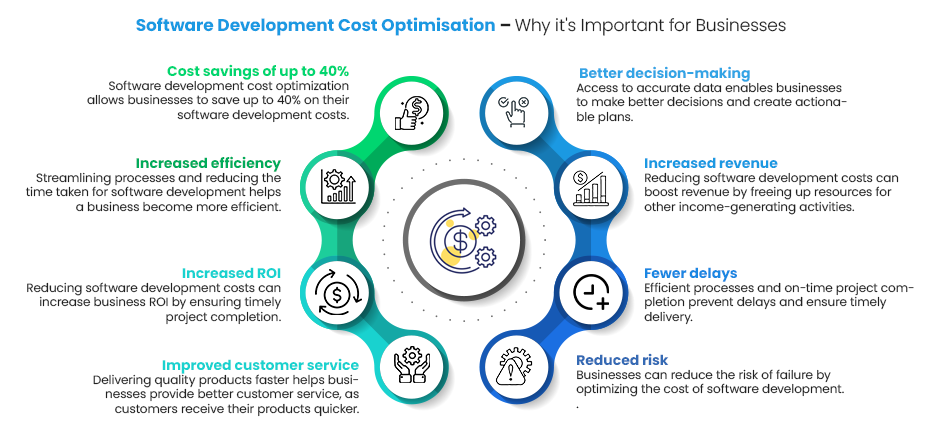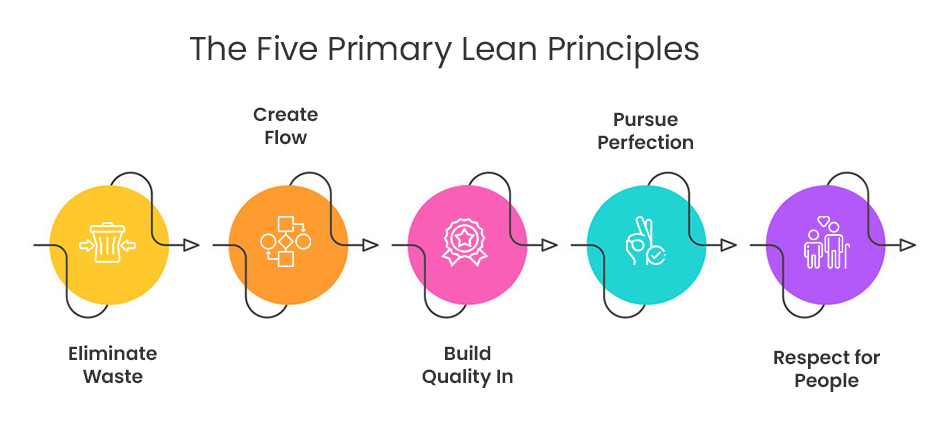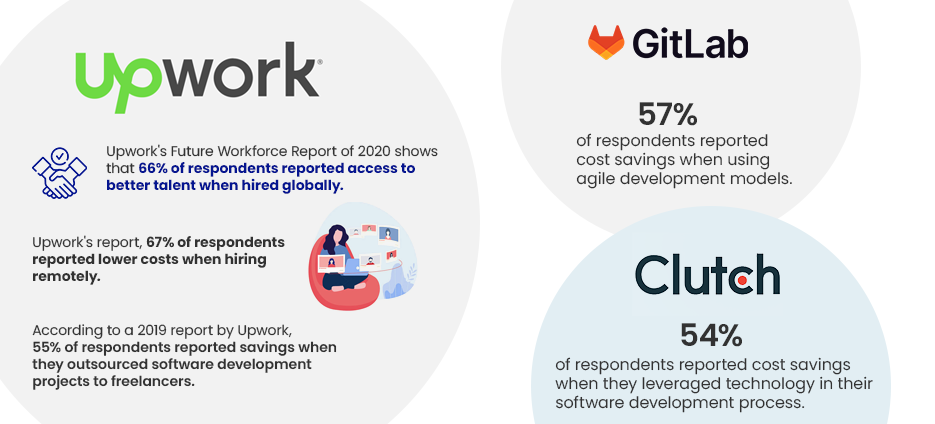Table of Contents
Software development is an ever-evolving field that has become increasingly important today. As technology advances, custom enterprise software development relies more on software applications to automate processes, streamline operations, and increase efficiency. However, with the rising costs of software development and maintenance, organizations must look for ways to optimize their Software development cost to maximize returns on investment. According to a report from Deloitte, software cost optimization can lead to significant cost reductions of up to 30%. Additionally, the National Institute of Standards and Technology (NIST) found that software development cost optimization can help organizations save up to 70% on their development costs.
Proven strategies for software development cost optimization and increased software efficiency include taking advantage of open-source solutions, utilizing cloud computing, and leveraging automation tools. Recent reports suggest that companies worldwide can reduce software development costs by up to 38% through these strategies like many blockchain software development companies teach these strategies. Additionally, businesses can experience an average increase in their software efficiency of 40% using such systems. Therefore, taking advantage of proven strategies for custom software development cost optimization and increasing software efficiency can be an excellent way for companies to maximize their investments.
Transform Your Software Vision into Reality – Book A 30 Minutes Free Consultation!
Why is Software Development Cost Optimisation Important for any organization?
Software development cost optimization is essential for any organization, regardless of size or industry. It involves careful analysis and planning to ensure that resources are used effectively, and expenses are minimal. Cost optimization helps organizations save money while maintaining the quality of their software products and services.
- Developing software in the US can cost anywhere from $50 to $250 per hour for a freelancer or $75 to $150 per hour for an agency. The final cost may vary based on project complexity, programming languages, and hardware needs.
- Setting up an in-house software development team can cost anywhere from $50,000 to $200,000, including staff salaries, hardware, software licenses, and other related expenses.
- Developing a mobile app costs anywhere from $10,000 to $250,000, depending on platform, features, and complexity.
The cost of software maintenance and updates can vary from $10 to $500 per hour, depending on the complexity of the updates. This includes bug fixes, security updates, feature enhancements, and other related tasks.
Organizations can reduce costs by improving efficiency in software testing strategies processes by making more informed decisions about their technology investments.
1. Utilize Automation
Automation in software development processes can reduce costs by eliminating manual labor and increasing productivity. Automated tools like code refactoring, test automation, and continuous integration can streamline operations and reduce development time.
2. Invest in Quality Assurance
Quality assurance is an integral part of software development cost optimization. By investing in quality assurance processes, organizations can identify issues early on, which can save money by avoiding custom software development delays or re-work further down the line.
3. Adopt Agile Methodologies
Agile methodologies such as Scrum and Kanban can help organizations reduce costs by speeding up development cycles. By breaking down projects into smaller chunks, teams can focus on specific tasks at a time, which helps to speed up the overall process.
4. Utilize Low-Code Platforms
Low-code development platforms such as Mendix and OutSystems can reduce costs by eliminating the need for costly custom development. Low-code solutions can be used to create custom applications quickly and easily, saving custom software development for startups time and money.
5. Utilize DevOps
DevOps is an approach to software development that emphasizes Automation and collaboration. Using DevOps tools such as Jenkins and Ansible, custom software development services can improve speed and efficiency while reducing costs associated with manual processes.
6. Manage Software Licenses
Managing software licenses can reduce costs associated with software development. By keeping track of which rights are in use and when they expire, organizations can ensure that they only pay for them.
7. Utilize Cloud Services
Cloud services such as Amazon Web Services (AWS), Google Cloud Platform (GCP), and Microsoft Azure can reduce costs by providing on-demand scalability and cost-effective storage healthcare software solutions.
8. Utilize Source Solutions
Open-source solutions can help organizations save money by avoiding licensing costs associated with proprietary software. Additionally, open-source solutions are often more secure and reliable for digital transformation services than their proprietary counterparts.

13 Best Key Components to Reduce the Software Development Cost
Developing software can be a costly venture for businesses. However, there are ways to reduce the cost of software development and still achieve effective results. According to a study conducted by Harvard Business Review, software development projects can cost up to $20 million for large enterprise applications and $2 million for smaller ones. Furthermore, Gartner estimates that 25% of all IT projects fail due to budget overruns and schedule delays. By understanding key components that help reduce the cost of software development, businesses can create software solutions that meet their needs without breaking the bank. Here are 13 best features that can help reduce the cost of software development.
1. Utilize Low-Code Development Platforms
Low-code development platforms such as Mendix and OutSystems can reduce the cost of software development by eliminating the need for costly custom development. Low-code solutions can create custom applications quickly and easily, saving organizations time and money by adopting software testing strategies.
2. Invest in Quality Assurance
Quality assurance is an essential part of reducing software development costs. By investing in quality assurance processes, organizations can identify and fix issues early on, which can save money by avoiding costly delays or re-work further down the line.
3. Adopt Agile Methodologies
Agile methodologies such as Scrum and Kanban can help reduce software development costs by speeding up development cycles. By breaking down projects into smaller chunks, teams can focus on specific tasks at a time, which helps to speed up the overall process.
4. Utilize DevOps
DevOps is an approach to software development that emphasizes Automation and collaboration. By using DevOps tools such as Jenkins and Ansible, organizations can improve speed and efficiency while custom software development services reduce costs associated with manual processes.
5. Manage Software Licenses
Managing software licenses can reduce costs associated with software development. By keeping track of which requests are in use and when they expire, organizations can ensure that they only pay for the licenses being used.
6. Utilize Cloud Services
Cloud services such as Amazon Web Services (AWS), Google Cloud Platform (GCP), and Microsoft Azure can reduce costs by providing on-demand scalability and cost-effective storage healthcare software solutions.
7. Utilize Open Source Solutions
Open-source solutions can help organizations save money by avoiding licensing costs associated with proprietary software. Additionally, open-source solutions are often more secure and reliable than their proprietary counterparts.
8. Automate Repetitive Tasks
Automating repetitive tasks can reduce the cost of software development by freeing up developer time. Organizations can focus their resources on more critical aspects of development by automating tedious tasks such as code reviews and testing.
9. Invest in Security
Investing in security measures can reduce the cost of software development by preventing costly data breaches and other cyber attacks. Organizations can protect their data by investing in security tools such as firewalls and encryption while reducing development costs.
10. Utilize Free Tools
Free tools such as GitHub and Bitbucket can help organizations save money by eliminating the need to purchase software licenses. Additionally, free tools often have a large community of developers willing to help with bug fixes and other issues.
11. Reuse Existing Code
Reusing existing code can reduce the cost of software development by eliminating the need to write new code. By leveraging existing code, developers can quickly build on existing functionality while avoiding custom software development cost re-writes.
12. Implement Standards and Best Practices
Implementing standards and best practices can help reduce costs associated with software development. By following industry standards and best practices, organizations can ensure that software is developed cost-effectively and securely.
13. Create an Onboarding Process
Creating an onboarding process can reduce the cost of software development by ensuring that new developers are up to speed quickly. By providing clear guidelines and expectations, organizations can ensure that new developers can hit the ground running and start contributing immediately to software development project management.
Elevate Quality, Elevate Success! Click to Explore Our Software Development Services
What is the Importance of Smart Resource Allocation to Enhance Efficiency Without Inflating the Budget?
Smart resource allocation is critical in achieving efficiency without inflating the budget. It involves effectively using resources, such as labor, materials, time, and money, to maximize results and reduce costs. Organizations can achieve greater efficiency by allocating resources more effectively without increasing their budgets for digital transformation services.
According to a recent report, intelligent resource allocation can help organizations enhance efficiency without inflating their budget. This is achieved by determining the most effective use of resources, such as workforce, time, materials, and finances. Organizations can achieve greater productivity with lower costs when resources are allocated efficiently. The report proved that intelligent resources in software testing strategies and allocation help organizations reduce costs while improving performance.
By analyzing the usage of resources, organizations can identify areas where costs can be reduced or performance improved. For example, by optimizing employee schedules and workloads, software development services in USA can reduce labor costs while boosting productivity. Similarly, an efficient use of materials will help in reducing waste and cutting down on unnecessary expenses.
Here are some ways that intelligent resource allocation can enhance efficiency without inflating the budget:
1. Consolidate tasks
Resource allocation should involve consolidating similar tasks so they can be completed simultaneously instead of spending time on multiple activities that achieve the same goal. This helps reduce labor costs and improve efficiency.
2. Invest in the right technology
By investing in the right technology, organizations can automate specific tasks and free up personnel time for other activities. Custom software development services will help organizations save on labor costs while increasing efficiency.
3. Utilize existing resources
Organizations should use their existing resources to their fullest potential before spending money on new equipment or services. This will help them reduce costs while still obtaining the desired results.
Smart resource allocation can also help organizations achieve greater agility in responding to changing conditions. With an effective resource allocation strategy, custom software development for startups can quickly adjust their operations to take advantage of new opportunities or address unexpected problems. By following these tips and including artificial intelligence in software development, organizations can achieve greater efficiency without increasing their budgets. Smart resource allocation is essential for cost-effectiveness and ensuring that money and resources are used wisely.
Finally, intelligent resource allocation can help organizations remain competitive in the marketplace. By making sound decisions about allocating resources, organizations can ensure that they can stay ahead of the competition and continue to grow their custom enterprise software development companies .
How can Efficient Testing Practices Reduce Software Development Costs?
Software development is costly, and ensuring that the end product is of the highest quality is critical. Efficient testing practices can reduce software development costs by providing the software functions correctly and meeting user requirements. Regarding software development cost, the time and resources spent are vital factors. According to a report by Forbes, companies should generally budget for about 6 months from start to finish for small projects and up to 12 months for large ones.
Additionally, Statista estimates that software development costs can range anywhere from $100,000 to $500,000, depending on the size and complexity of the project. Finally, Forbes also notes that companies should invest an additional 10-20% of the total budget for unforeseen circumstances. Through proper testing procedures, custom software development companies in USA can identify defects earlier in the development process, allowing them to address issues before they become too costly or time-consuming.
Here are some ways that efficient testing practices can reduce the software development cost:
1. Automation
Automating specific test procedures can reduce costs by reducing the time and effort required to test software manually. Automated tests can be run quickly and can be used to identify defects early in the development process.
2. Early Identification
Identifying defects early in the software development process can save time and money since fixes are usually less costly when issues are found and addressed earlier. By running tests regularly, developers can quickly identify and address problems before they become more challenging to fix.
3. Continuous Quality Assurance
Continuous quality assurance ensures software meets user requirements and functions correctly. By running tests regularly, developers can quickly identify and address problems before they become more challenging to fix.
4. Test Case Prioritization
By prioritizing the test cases that need to be tested first, developers can reduce the cost of software development by reducing the time and resources spent on unnecessary tests. Additionally, prioritizing tests can help developers identify and fix bugs quickly.
By utilizing efficient testing practices, organizations can save time and money while ensuring the software they develop is of the highest quality. Through proper testing procedures, developers can identify defects early in the development process and take measures to address them before they become too costly or time-consuming to fix.
Empower Your Business with Cutting-Edge Software. Request a Free Consultation Today!
How do Lean Principles Reduce Waste and Enhance Software Development ROI?
Lean principles are a set of production and management practices developed by Toyota in the 1950s. They focus on eliminating waste and improving efficiency while delivering high-quality products. This same set of principles is now being applied to software development to reduce waste and increase Return On Investment (ROI). Lean Principles are based on eliminating anything that does not add value to a product or service. Several primary software development services in the USA, including Toyota, Dell, Amazon, Apple, and Microsoft, have adopted this approach. This section will discuss how Lean principles can reduce waste and enhance software development ROI.
1. Streamlining the Process
Lean principles focus on removing unnecessary steps and streamlining the software development process. This can reduce waste by eliminating redundant activities and identifying areas where work can be done more efficiently. By focusing on software testing strategies and improving workflow, teams can get better results with less effort, resulting in increased ROI.
2. Automation
Automating specific tasks can make the development process more efficient and reduce the time and effort required to complete a project. This can result in faster development times, which translates into higher ROI.
3. Continuous Improvement
Lean principles focus on continuous improvement, which means that teams constantly look for ways to improve their processes and make them more efficient. Continuous improvement with custom software development companies in USA helps ensure that teams produce the highest quality software with the least effort and resources, resulting in a higher ROI.
4. Cross-Functional Teams
Lean principles emphasize the importance of cross-functional teams. This allows teams to work together more efficiently and utilize each other’s strengths to create better software. By working together in this way, teams can reduce waste and get the best possible results, resulting in a higher ROI.
5. Collaborative Planning
Lean principles encourage teams to collaborate and plan out their work together. By doing this, teams can improve communication and reduce time spent on redundant activities. This can help ensure that the most critical tasks are prioritized and that resources are used efficiently, leading to higher ROI.
6. Eliminating Waste
Lean principles focus on eliminating waste and unnecessary steps in the software development process. By doing this, teams can identify areas where work can be done more efficiently and stop redundant activities. Custom software development cost helps ensure that teams are only spending time and effort on essential tasks, resulting in higher ROI.
7. Streamlined Communication
Lean principles focus on streamlining communication between teams. This helps ensure everyone is on the same page and completing all tasks properly. Communicating quickly and effectively can reduce the time needed to complete projects, resulting in higher ROI.
8. Prioritizing Tasks
Lean principles emphasize prioritizing tasks based on their impact and significance. This helps teams focus on the tasks that will deliver the most significant ROI.

Benefits of Incorporating Open-source Tools and Frameworks to reduce development costs
Open-source tools and frameworks are becoming increasingly popular among software developers as they effectively reduce development costs. These tools and frameworks offer a wide range of features that enable developers to build applications without purchasing expensive proprietary software licenses. They offer access to many libraries, which can help reduce the time needed to develop the application. Additionally, custom software development outsourcing often comes with comprehensive documentation and is supported by a large community of users that can assist.
1. Cost Savings
Open-source tools and frameworks can help reduce development costs significantly, as they often require no license fees. This makes them ideal for projects with tight budgets or where cost savings are a priority.
2. Increased Efficiency
Open source tools and frameworks often come with comprehensive documentation and tutorials, which can reduce the time needed to develop the application. Additionally, they usually have a wide range of features that can be used to build an application with less effort and cost.
3. Large Community
Open-source tools and frameworks are supported by a large community of users who provide assistance and advice when needed. This can help developers quickly get the help they need when working on a project.
4. Reliability
Open source tools and frameworks are highly reliable, as they are developed by an open community of developers who continuously improve and update them. Reliability and software testing strategies help ensure that applications built with these tools will be robust and stable.
5. Flexibility
Open source tools and frameworks are highly versatile, enabling developers to easily modify the code or add features to an application. This allows them to tailor an application according to their specific needs.
6. Security
Open-source tools and frameworks have built-in security measures that help protect applications from malicious attacks. Additionally, they often have additional security features that can be implemented to enhance the security of an application further.
How Methodologies Can Help Adjust Budgets Dynamically Based on Evolving Project Requirements?
In today’s ever-changing business environment, organizations must be able to adjust their budgets based on evolving project requirements flexibly. To ensure that budgets can be adapted quickly and efficiently, blockchain software development companies must have a set of methodologies in place. These methodologies help ensure that the organization has the necessary tools and processes to effectively manage its budget in response to changing needs in place to make budget adjustments based on changing project requirements.
1. Agile Methodology
The Agile methodology is a popular choice for organizations that need to adjust their budgets dynamically. It emphasizes the importance of quickly adapting to changing conditions, ensuring that the budget can be adjusted when necessary. Additionally, it helps to ensure that teams are focused on delivering the highest value product.
2. Lean Methodology
The Lean methodology is another popular option for businesses that need to adjust their budgets quickly and efficiently. It focuses on eliminating waste and increasing efficiency, helping organizations allocate resources and adjust their budgets accordingly. Additionally, it helps to ensure that any changes are made in a way that will impact the outcome of the fintech software development services project.
3. Risk Management
Risk management is another critical element of adjusting budgets dynamically. By monitoring the potential risks associated with a project, organizations can better anticipate and plan for changing requirements. Additionally, risk management techniques can ensure that any budget modifications are made to minimize potential impacts on the overall project outcome.
4. Scrum Methodology
The Scrum methodology is an excellent choice for organizations that need to modify their budgets quickly and efficiently. It emphasizes collaboration, allowing teams to collaborate and share ideas to make the most of available resources. Additionally, it helps to ensure that any changes made are implemented promptly.
5. Waterfall Methodology
The Waterfall methodology is a traditional approach to budget management that emphasizes structure and order. This helps organizations ensure that any changes made are organized, helping to provide clarity and control of resources. Additionally, custom software development companies in the USA can help teams track progress better and ensure that any budget modifications are implemented most effectively.
6. Budget Planning
Establishing a budget plan is an essential step in adjusting budgets dynamically. This plan helps organizations better understand the current state of their resources and identify areas where adjustments may be needed. Additionally, budget planning can help teams create realistic goals and projections for future spending, allowing them to better prepare for changing project requirements.
Finally, it is essential to have an effective communication strategy in place when adjusting budgets dynamically. This helps ensure that all stakeholders know about changes and can work together to manage budget modifications effectively. Additionally, it provides that any adjustments made are made in an organized and effective manner.
Looking for a Tech Upgrade? Let’s Build Your Next Software Solution Together!
Strategies for Exploring Global Talent to Optimize Software Development Cost
Organizations seek strategies to optimize software development costs and explore global talent in today’s highly competitive business environment. The advent of digital technology has enabled organizations to seek out talent anywhere in the world, allowing them to reduce costs, increase efficiency, and gain access to a broader pool of skills. This section will discuss 8 strategies for exploring global talent to optimize software development costs.
1. Utilize Online Platforms
Organizations can quickly and easily access a vast global talent pool using online platforms such as Upwork. This allows them to target the correct skill set for their needs at a competitive price.
2. Leverage Freelance Developers
Many talented developers have chosen to become freelance rather than work full-time for an employer. Organizations can use freelance developers to reduce their software development costs and benefit from the wide range of skills available.
3. Outsource to Nearshore Teams
Nearshore teams are located in countries near the organization’s headquarters, usually within the same region or time zone. Fintech software development services allow them to benefit from cost savings while enjoying a high-quality service.
4. Identify Key Talent Quickly
To identify key talent quickly, organizations should use practical online tools such as LinkedIn or Stack Overflow to scout out the best developers for their needs. This can help them to reduce software costs by finding the right person for the job efficiently.
5. Partner with Software Development Companies
Organizations should consider partnering with software development companies for larger, more complex software development needs. Custom software development outsourcing allows them to benefit from expertise in specific areas of software development while still taking advantage of cost savings.
6. Use Contests and Competitions
Organizations can tap into a global talent pool by running contests or competitions and identifying potential developers who can bring fresh ideas and solutions.
7. Leverage Open Source Projects
By leveraging open source projects, software development companies in the USA can benefit from a larger pool of skilled developers without having to pay for each one individually. This allows them to save costs while still utilizing the skills in the open-source community.
8. Utilize On-Demand Services
On-demand services like Amazon Web Services allow organizations to access various skills and services on demand. This will enable them to quickly respond to changing needs or tap into new talent when needed.

Conclusion
Software development cost optimization and efficiency is a complex issue that requires careful planning and implementation. To ensure successful results, there must be effective strategies in place. Three proven strategies for software development cost optimization and increasing software efficiency are focusing on quality assurance, introducing Automation into the process, and investing in skilled talent.
Quality assurance should always be the top priority for blockchain software development companies when developing software. It’s essential to thoroughly test all aspects of the product and ensure that it meets the requirements and specifications of the client. Automation is a great way to streamline processes and reduce costs associated with manual labor. Investing in skilled talent can also pay off in the long run, as these professionals can help create solutions faster and more efficiently.
By using these strategies, software development costs can be significantly reduced, and the efficiency of the software will be increased. Utilizing online platforms, leveraging freelancers nearshoring teams, identifying critical talent quickly, partnering with software development companies, using contests and competitions, leveraging open source projects, and utilizing on-demand services are all strategies that can help reduce custom software development costs while increasing efficiency.
From ‘What If’ to ‘Aha!’: Our FAQs Transform Curiosity into a Symphony of Enlightening Answers!
1. What are proven strategies for software development cost optimization?
Answer: Proven strategies for software development cost optimization include reducing complexity, streamlining processes, using open source software, and reusing existing code. Additionally, outsourcing non-core tasks and embracing Automation can reduce costs for many software development companies in the USA.
2. How can I increase software efficiency?
Answer: Decreasing complexity, streamlining processes, and focusing on quality assurance are all effective ways to increase software efficiency. Automating repetitive tasks with scripts or macros can reduce the number of manual labor hours required and improve efficiency. Investing in skilled talent can help create solutions faster and more efficiently.
3. What is the importance of quality assurance in software development?
Answer: Quality assurance is essential in software development to ensure the product meets requirements and specifications. Thoroughly testing all aspects of the product before launching is necessary to ensure quality and success.
4. How can Automation reduce costs?
Answer: Automation can reduce costs by streamlining processes and reducing manual labor hours. Automating repetitive tasks with scripts or macros can save time and money, enabling organizations to focus their resources on more critical projects.
5. What are the advantages of nearshoring teams?
Answer: Nearshoring teams offer the advantage of accessing skilled talent more quickly and cost-effectively. Additionally, nearshored teams often possess native language skills that can be beneficial for navigating local regulations and cultural differences.
6. What are some strategies for leveraging open source projects?
Answer: Leveraging open source projects can help reduce software development costs while allowing organizations to benefit from quality resources. Additionally, open source projects often provide a platform for collaboration and help speed up the development process.
7. What are the benefits of utilizing online platforms?
Answer: Utilizing online platforms can help reduce costs associated with software development by allowing organizations to access skilled talent quickly and cost-effectively. Additionally, these platforms often provide a platform for collaboration and help speed up the development process.
8. How can contests and competitions be used to reduce costs?
Answer: Contests and competitions can reduce development costs by allowing organizations access to skilled talent worldwide at a fraction of the cost. These competitions also offer an opportunity for creative solutions provided by custom software development outsourcing while providing a platform for collaboration between contestants.






